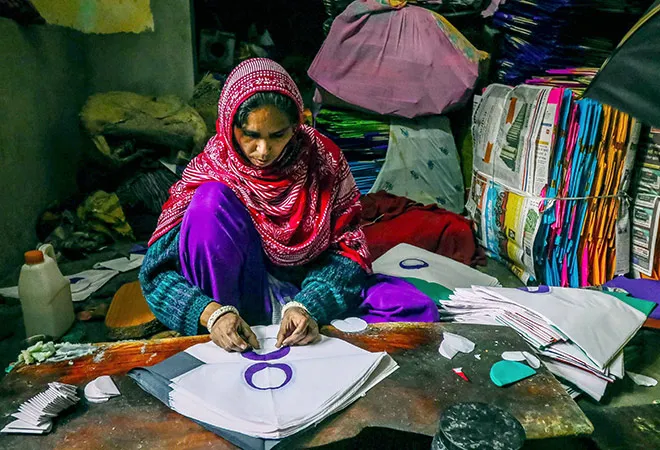-
CENTRES
Progammes & Centres
Location
Strengthening the credit structure to help MSMEs will be important in 2019.

Image Source: PTI
India’s Micro Small and Medium Enterprises (MSMEs) are vital for the economy as they contribute around 8 per cent to the GDP and employ the largest number of people in the industrial and services sectors. There are 50 million or so MSMEs, both registered and unregistered, in India and they contribute 6.11 percent of the manufacturing GDP and 24.6 per cent of the services GDP.
There are 12 crore employees in MSMEs in India today, second only to agriculture. They also employ the maximum number of women workers. Many of the micro and small-scale units come under the informal sector due to their size and low capital base. They absorb the constant flow of migrant labour coming from the countryside to seek jobs in towns and cities. No wonder the government is focused on MSMEs because they are the biggest job provider and jobs will be a big election issue this year.
Among the many problems that MSME sector suffers from, like infrastructure and lack of latest technology, struggling with credit growth for the last four years has been one of the main problems. Hence, it needs immediate attention. The government asked the Reserve Bank of India (RBI) to study their problems in order to ease the credit supply to MSMEs, especially after the IL&FS infrastructural company’s fiasco and collapse and its effect on the NBFCs (Non-Banking Finance Companies) or shadow banking companies which ran into deep trouble because of the liquidity crunch that followed. They are the main source of finance for the MSMEs.
Among the many problems that MSME sector suffers from, like infrastructure and lack of latest technology, struggling with credit growth for the last four years has been one of the main problems.
The MSMEs were very much affected by demonetisation in November 2016 as a result of which their growth was arrested. Their operations are mostly cash based and hence due to sudden disruption in cash flow due to demonetisation, they could not pay for their running costs easily. Another problem arose when they had to adjust to obligations under the GST regime, requiring them to file papers for refunds on input taxes. In small enterprises, this kind of expertise is not normally available and they had to engage professional accountants whose fees and charges cut into their thin profits.
After the double whammy, the government has come up with ways to boost the sector due to its importance in the economy, especially in manufacturing and exports. First, it came up with a scheme that would grant loans to them up to Rs 1 crore in 59 minutes. Then the RBI, at the behest of the government, has come up with a restructuring scheme of existing MSME loans that have defaulted but are not non-performing assets as on 1 January, 2019. Such restructuring would not lead to a downgrade in asset classification. But to be eligible, the aggregate exposure, including non-fund facilities of banks and NBFCs, the borrower should not have exceeded Rs 25 crore in loans. Under the scheme, lenders have to set aside 5 per cent of the outstanding loan as ‘provision’ over and above the outstanding amount (provisioning is setting aside of money from profits to compensate for a probable loss caused by lending). All standard loans attract 0.4 per cent provisioning. The restructuring scheme ensures that MSME loans do not slip into non-performing asset category requiring 15 per cent provisioning.
MSMEs can approach banks and non-bank lenders to restructure the loans up to Rs 10,000 crore without classifying them as bad debt. It is known in the industrial parlance as regulatory forbearance.
It has been the experience in the past that such restructuring was widely misused for evergreening of bad corporate loans during the period 2011-13. The MSME sector since the last four years has been burdened with huge loans. According to Small Industries Industrial Development Bank (SIDBI), total loans to non-individual MSME borrower under Rs 25 crore mark stood at Rs 13 lakh crore in September 2018.
MSMEs can approach banks and non-bank lenders to restructure the loans up to Rs 10,000 crore without classifying them as bad debt. It is known in the industrial parlance as regulatory forbearance.
The larger MSMEs have been borrowing from banks and NBFCs and thus may benefit most from restructuring provision as their stressed loans in the Rs 10 to Rs 25 crore category has been the highest. But the smaller MSMEs have found it difficult to access formal financing, especially since the liquidity crisis hit the NBFC sector in October 2018. But with restructuring tool at their disposal, lenders may now be able to regain their confidence in lending to even smaller MSME borrowers.
The lowest rated MSMEs have a 20 per cent exposure to public sector banks and it is they whose default rate has been the highest. The RBI has in such circumstances eased, rather than tightened, the norms for their (PSBs) lending to MSMEs. As pointed above, its experience with ‘forbearance’ has not been encouraging because until April 2015, banks were allowed to restructure loans without marking them as NPAs.
Another way of helping small and medium enterprises, currently being considered by the government, is to raise the threshold for GST registration. MSME sales threshold for companies for compulsory GST registration may be raised to Rs 40 lakhs in the future. This will make many smaller MSMEs happy as it will bring them relief from the paper work of filing returns. The advantage of a lower sales threshold for GST registration, however, is that it helps in the formalisation of the economy. Otherwise, companies without registration will not be eligible for labour welfare schemes under the Employers’ Provident Fund organization or indirect tax refund scheme.
The earlier 20-lakh threshold was instrumental in bringing in a large number of small businesses into GST net and the tax exemption limit prior to July 1, 2017 for central excise duty was Rs 1 crore in annual sales. The sales threshold is to be raised to 1.5 crore. In the earlier system, the tax payer base got expanded with a lower threshold.
On the whole, strengthening the credit structure to help MSMEs will be important in 2019 and it is the only sector which will be a big generator of jobs. It has also to be refurbished with better infrastructure, technology, skill development and innovations as MSMEs are facing unfair competition from cheap Chinese imports. The problems of MSMEs are constraining their growth, especially in export production. Today, MSMEs are in a worse position than four years ago because banks have become more concerned by their own NPAs and enhanced capital provisioning to lend to MSMEs on easier terms. Hence, there is a need for immediate action.
The views expressed above belong to the author(s). ORF research and analyses now available on Telegram! Click here to access our curated content — blogs, longforms and interviews.

Jayshree Sengupta was a Senior Fellow (Associate) with ORF's Economy and Growth Programme. Her work focuses on the Indian economy and development, regional cooperation related ...
Read More +
David Rusnok Researcher Strengthening National Climate Policy Implementation (SNAPFI) project DIW Germany
Read More +